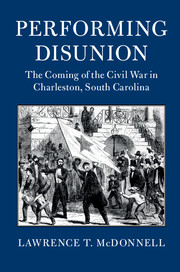18 - Heroes, One and All
from CRISIS: FIRE AND SWORD
Published online by Cambridge University Press: 08 June 2018
Summary
The Vigilants offered a broad road to honor and respectability for young men unable to attain those goals by other means in the difficult 1850s. All Charleston firemen longed to be seen as manly and respectable, both as a measure of social status and as proof of worthiness for advancement. This comes through in their constitutions and proceedings, their dress and public behavior, in self- promotion in the city's press. As with volunteer militia units, the structure of the fire companies united corporate, political, quasi- military, and social functions. Monthly meetings were usually brief, routine, and back- patting. There were dinners and parades to be coordinated, prospective members to examine and induct, old comrades to praise or salute in parting, elections and competitions to conduct, newspaper announcements to write up. However trivial, these activities provided a crucial ritual of recognition and reaffirmation – a glorified form of hat- tipping. Each man in the hall belonged there: all dressed and acted the part of responsible, gregarious men, blending civic service and bourgeois leisure.
Mose would have found it dull, but understood the impulse nonetheless. More to his taste was the revelry that followed. Virtually every meeting concluded with a convivial “supper or punch treat,” ex- Phoenix company fireman Toomer Porter recalled, and the delights of the “flowing bowl” carried on late into the night. Here was “an interchange of all those social feelings which give zest to life,” the Marions recorded, “and joy in our howl of Triumph.” Yet the rigmarole of the firemen's meeting was more than a pretext for the business of homosocial carousing. Mechanisms of restraint and release were two sides of the same coin of respectable masculinity. Their combination here constructed the fireman as “one of the b'hoys” within a context of manly self- control. The fellow who could not rollick with other men was an Automaton; the man unable to rein in his passions was a brute. Monthly meetings provided volunteers with comforting reassurance of identity and self- worth within the community of men, oscillating between leisure and duty
- Type
- Chapter
- Information
- Performing DisunionThe Coming of the Civil War in Charleston, South Carolina, pp. 358 - 376Publisher: Cambridge University PressPrint publication year: 2018



